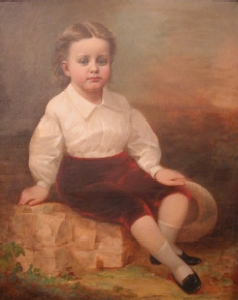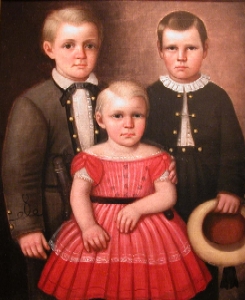The
Little Ones
Portraits
of Children from The Filson Historical Society
“ Between the dark and the daylight, When the night is beginning to lower, Comes a pause in the day’s occupations, That is known as the Children’s Hour.”
HENRY
WADSWORTH LONGFELLOW (1807-1882)
THE CHILDREN’S HOUR
FIRST PUBLISHED IN 1863
By Estill Curtis Pennington
Visiting Curator of Fine and Decorative Arts
About |
 The Filson’s large collection of portraits
of children by noted artists
who worked in the Ohio Valley region
is interesting for two very different
reasons. As works of art they offer a
wide variety of style, ranging from the
romantic to the naturalistic and from
the sophisticated to the naïve. As images
of children they open a window
into 19th-century notions of innocence
and experience and also occupy a cultural
terrain whose geography would
seem to exist as a separate country.
The Filson’s large collection of portraits
of children by noted artists
who worked in the Ohio Valley region
is interesting for two very different
reasons. As works of art they offer a
wide variety of style, ranging from the
romantic to the naturalistic and from
the sophisticated to the naïve. As images
of children they open a window
into 19th-century notions of innocence
and experience and also occupy a cultural
terrain whose geography would
seem to exist as a separate country.
In general terms, children in art from the 17th-century Baroque period through the 19th century were more often represented as young adults than as unique juvenile individuals set apart from adult concerns. One of the most admired children’s portraits of all time, Anthony Van Dyke’s painting of the five children of Charles I, depicts all the subjects dressed in court attire of the period, with cloaks and caps and dresses not unlike those worn by adults. In the 19th century, however, children were increasingly attired in “baby clothes,” usually of a highly androgynous nature, which concealed the child’s gender and kept it concealed until nearly the age of 5.
The culture of the child also extended to literature. Many children’s books, including several by Kentuckians, were published during this time. McGuffey’s “readers” taught reading with text specifically aimed at a younger audience. In late 19th-century Kentucky there was an abundance of writers who created heroes and heroines based on the very young, including Annie Fellows Johnston’s Little Colonel and John Fox Jr.’s Little Shepherd. The role assigned to these children most often called them to bring a fresh perspective to a stale adult conflict.
 Several intriguing artistic issues
arise as well when considering The
Filson’s holdings. The portrait by J. T.
Poindexter and William Frye have a
certain naïve quality calling into question
whether their actual composition
was based on existing print sources
from European works in the grand
manner. The exotic coloration in the
three paintings by W. B. Cooper signals
a transition from the romantic to the
impressionistic amongst painters in
the South. The boldly plain works by
“Craft” demand a willing suspension
of disbelief on the part of the viewer, as
they are far larger than life and much
less lifelike.
Several intriguing artistic issues
arise as well when considering The
Filson’s holdings. The portrait by J. T.
Poindexter and William Frye have a
certain naïve quality calling into question
whether their actual composition
was based on existing print sources
from European works in the grand
manner. The exotic coloration in the
three paintings by W. B. Cooper signals
a transition from the romantic to the
impressionistic amongst painters in
the South. The boldly plain works by
“Craft” demand a willing suspension
of disbelief on the part of the viewer, as
they are far larger than life and much
less lifelike.
The study of portraiture is often a study of ambitious intent. Parents desiring an image of an adored offspring sought artists ambitious to rise to the occasion. Unlike the likenesses of statesmen, generals and captains of industry, these “little ones” provoke us to call into question some of the more subtle questions of domestic life and culture as it existed in those now long gone days.
The Filson Historical Society
1310 South Third Street - Louisville, KY 40208
Phone: (502) 635-5083 Fax: (502) 635-5086
Hours
The Ferguson Mansion and Office
Monday - Friday: 9 am. - 5 pm.
Saturday and Sunday closed
Library
Monday - Friday: 9 am. - 5 pm.
Saturday: 9 am. - 12 noon
